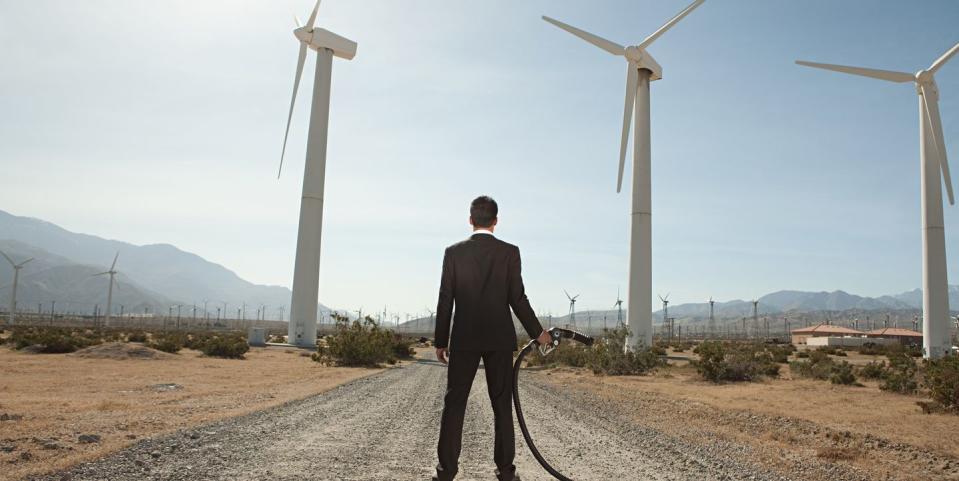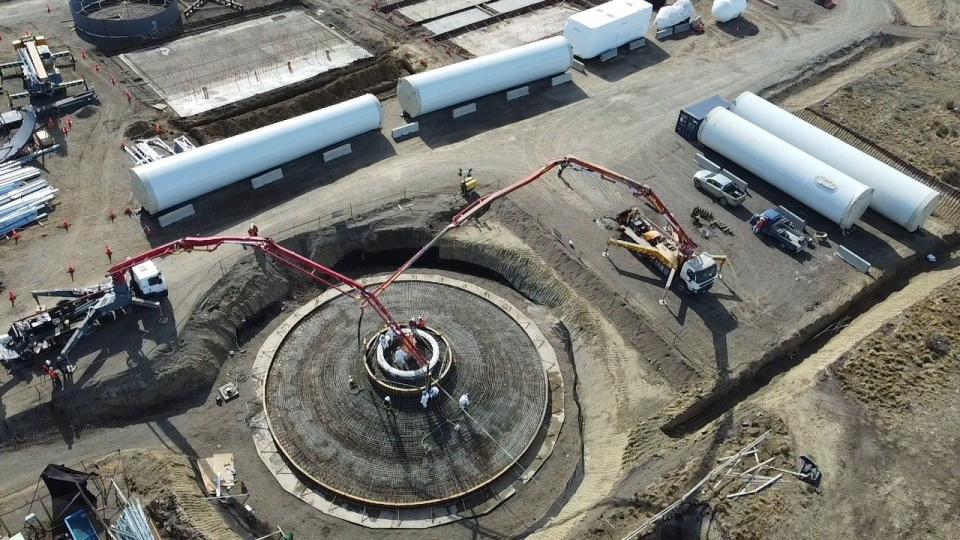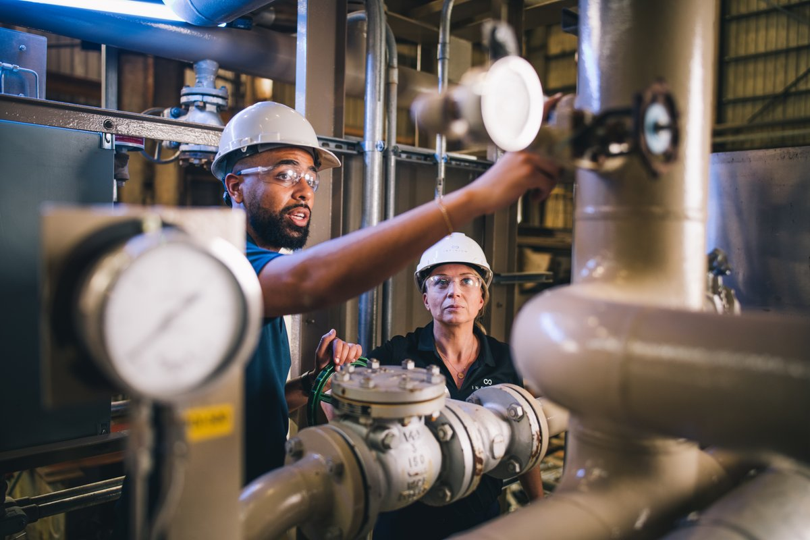How Climate-Friendly Gasoline May Yet Have a Place in Our EV Future

"Hearst Magazines and Yahoo may earn commission or revenue on some items through the links below."
The European Union voted to phase out internal-combustion cars by 2035, with the goal of economy-wide climate neutrality by 2050.
The agreement, however, contains a possible loophole allowing for e-fuels, with manufacturers being asked to make a case by 2026 for the feasibility of “CO2-neutral fuels.”
E-fuels are synthetic gasoline or diesel built up from a combination of renewably produced hydrogen from water via hydrolysis and captured carbon dioxide (CO2).
European Parliament lawmakers voted in June to phase out internal-combustion cars by 2035, with the goal of economy-wide climate neutrality by 2050. But in 2035 there will probably still be millions of gas-burning cars on the road—just as there were horses after the first horseless carriages appeared.
Could the remaining tailpipes be given a pass if they’re powered with carbon-neutral electrofuel (e-fuel), essentially synthetic gasoline or diesel built up from a combination of renewably produced hydrogen from water via hydrolysis and captured carbon dioxide (CO2)? Some European automakers are saying yes.
The European agreement looks iron-clad, but due to pressure from the Liberals that are part of Germany’s ruling coalition, it contains a possible loophole that e-fuels hope to drive through. Manufacturers are being asked to make a case by 2026 for the feasibility of “CO2-neutral fuels.” And this language was inserted into the draft regulation:
“Following consultation with stakeholders, the Commission will make a proposal for registering after 2035 vehicles running exclusively on CO2 neutral fuels in conformity with EU law, outside the scope of the fleet standards, and in conformity with the Union’s climate neutrality objective.”
Germany is a major automaker, and some (not all) of the leading players are backers of e-fuels. The greatest support has come from Porsche, though the VW Group itself has offered a full-throated embrace of electrification. The situation is somewhat complicated. The VW Group’s new chairman, Oliver Blume, who came over from Porsche, said during his tenure there that the automaker supported “a double e-path: e-mobility and e-fuels.” He added, “I support the German government’s open approach with regard to the technology and the coalition’s compromise to incorporate e-fuels as part of the solution….Combustion engines can be powered with e-fuels in a virtually carbon-neutral manner.”

Blume, who starts his new job September 1, may have to modify his past position. He said recently that he didn’t exert any influence to get the loophole added. But Porsche wasn’t waiting to see how the legislation works out. Last spring, it invested $75 million in HIF Global LLC, a Chilean company working on e-fuels. Porsche helped fund the company’s Haru Oni pilot plant in Punta Arenas with Siemens and ExxonMobil, and with its $75 million now owns 12.5 percent of HIF. In the Chilean operation, HIF uses the abundant Patagonian wind energy as a renewable source. The company’s short-term goal is e-fuel at $7.44 per gallon.
Porsche is also working with ExxonMobil to test e-fuel in its Supercup race cars. And Formula One wants to be using a “100 percent sustainable fuel” by 2026. A Porsche research and development spokesperson, Hermann-Josef Stappen, said Porsche and supplier Bosch are also working together on an e-fuel project in the German state of Baden-Wuerttemberg. Bosch is definitely bullish on e-fuels. Said former CEO Volkmar Denner in 2021, “An opportunity is being missed if renewable synthetic fuel derived from hydrogen and CO2 remains off limits in road transport…Using renewable synthetic fuels can make combustion engines just as climate neutral as battery-powered vehicles.”
HIF has global ambitions. In May, it said that a new $6 billion e-fuels plant in Matagorda County, Texas with capacity of 200 million gallons annually will begin construction in 2024. Such a plant could be well-positioned to supply internal-combustion cars in California—the state is planning a 2035 ban similar to that in Europe.
In July, HIF also said it would start construction in 2024 on a plant in Australia with the goal of producing 100 million liters (26.4 million gallons) of e-fuel annually. The company said the Australian plant could “decarbonize” 52,000 cars at full operation, reducing emissions 260,000 tons annually. Earlier this year, an HIF office opened in Berlin, Germany.
HIF Global President and CEO Cesar Norton told Autoweek, “HIF Global’s expansion beyond our flagship facility in Chile into the United States, Europe, and Australia is in direct response to the growing demand for innovative energy solutions like we have developed with e-fuels. A carbon-neutral gasoline replacement that can be used in existing vehicles we believe is a critical means of fighting climate change through decarbonizing our atmosphere.”

Another US player is California-based Infinium, which has received backing from Amazon and Mitsubishi Heavy Industries, among others. As early as 2025, said Infinium CEO Robert Schuetzle, its partner Denbury will be able to deliver as much as 1.5 million tons of CO2 per year via pipeline to the new Infinium co-located facility in Texas. There is also a second project, Reuze, with a utility provider in Dunkirk, France.
Schuetzle told Autoweek that Infinium is focused on “the hardest areas to electrify,” including diesel for long-haul trucking, aviation fuel, and maritime applications such as container shipping. “We have a dozen projects at different stages,” he said, “but have only announced a few relationships.” The e-fuel alternative could be attractive for companies with large truck fleets—they could theoretically reach climate goals without replacing all their vehicles. Each of Infinium’s large-scale production facilities could mitigate more than 300,000 metric tons of CO2 annually, the company said.
Other automakers, including Mazda, McLaren, and Bentley, have also spoken positively about e-fuel. McLaren’s Jens Ludmann, the company’s chief operating officer, said in 2020 that synthetic fuels “can be produced using solar energy, easily transported and then pumped [into cars] as we know today, [and] there are potential benefits in terms of emissions and practicality that I’m keen to explore.”
Mazda’s research director in Europe, Christian Schultze, said last year, “We believe that e-fuels aren’t in competition with the electrification route but complement it. E-fuels can be used already on existing cars—and future cars. Having two pathways to follow can get us to climate-neutrality faster and better.”
Mercedes-Benz is not so sanguine, at least in the short term. Markus Schäfer, who heads research and development, told Autocar in 2020, “If you have an abundance of energy, the best use is to put it directly into a battery. To transform green energy into an e-fuel is a process where you lose a lot of efficiency.” BMW’s iVentures arm was an investor in carbon-neutral gasoline company Prometheus Fuels in 2020.
The first customer for e-fuel should be the aviation industry, Schäfer said. “Far, far later—I don’t see this in the next 10 years—will come the car industry.” On this point, Mercedes will have lots of agreement in the environmental community.
Jeremy Martin, director of fuels policy and senior scientist in the Clean Transportation Program at the Union of Concerned Scientists (UCS), told Autoweek that the processes for combining hydrogen and CO2 into a liquid fuel “are closely related to techniques used to make liquid fuels from coal, natural gas, or biomass, except that the hydrogen in a hypothetical e-fuel process is sourced from hydrolysis of water powered by renewable energy and the carbon comes from captured CO2.” These methods, which include Fischer-Tropsch, used to produce liquids from coal and developed in the 1920s, are well established.
UCS is “fairly skeptical about e-fuels, especially in the context of light-duty cars and trucks,” Martin said. “Synthetic gasoline or diesel may start as renewable electricity, but it is still a combustion fuel and will still produce harmful tailpipe pollution.” UCS sees a “small role” for e-fuels in applications where direct electrification is not practical, including aviation fuel.
Stephanie Searle, program director for fuels and US at the International Council on Clean Transportation (ICCT), also sees the fuel as better suited for aviation. “E-fuels absolutely can be part of global transport decarbonization,” she said. “It is imperative that [the e-fuels] are actually zero-carbon. And the problem is that zero-carbon e-fuels are very expensive. We calculate that e-fuels would cost around $9 per gallon if anyone were producing them at scale today, and $12 per gallon in the EU. No one is going to pay that to burn inefficiently in an internal-combustion car.”
Ralf Diemer, managing director of the supportive eFuel Alliance, said that synthetic gasoline was likely to become affordable in the relatively short term, maybe $4 a gallon by 2026. And planned Saudi Arabian production could be even cheaper, he said. Diemer noted the opposition from environmental groups to e-fuels for road transport, but suggested that long-haul trucking—which is not easily electrified—could be a good target.

The viability of biofuels going back decades has been at the mercy of rapidly moving pump gas prices. When motorists are paying $5 a gallon, such fuels can look attractive. But, as currently, such high prices tend to come down. E-fuel costs are also likely to come down, but no one is seeing parity with today’s gasoline prices. Porsche’s Stappen said that, when produced on an industrial scale, e-fuel could be reach $2 per liter (under $8 a gallon, approximately HIF Global’s goal).
The Europe-based Transport & Environment doesn’t think e-fuels are suitable for road vehicles. “It takes almost five times more electricity to drive a car running on e-fuel the same distance as a battery electric car,” the group told Autoweek. “Considering the large ramp-up in renewables that will be needed to decarbonize the EU, we cannot waste green electrons on inefficient e-fuels for cars…Cars powered by e-fuels also emit significantly more CO2 than battery electric vehicles over their lifecycle and pump out as much toxic NOx emissions as [gas] cars.” A briefing on e-fuels by the group is headlined “E-Fools.”
So far, this tempest is occurring mainly in Europe. If there’s a US push for e-fuels, it’s fairly low profile at this point. There is no federal mandate to abandon internal combustion here, though it is policy in some states, including California. Last year, 12 governors asked President Biden in a letter to enact a 2035 ban.
Are e-fuels a viable option for future internal-combustion applications? Best reserved for critical uses, such as aviation? Share your thoughts in the comments below.

 Yahoo Autos
Yahoo Autos 